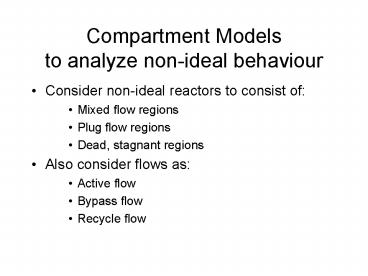Compartment Models to analyze nonideal behaviour - PowerPoint PPT Presentation
1 / 31
Title:
Compartment Models to analyze nonideal behaviour
Description:
Dead, stagnant regions. Also consider flows as: Active flow. Bypass flow. Recycle flow ... If we get an immediate peak (typically small) this indicates by-pass. ... – PowerPoint PPT presentation
Number of Views:68
Avg rating:3.0/5.0
Title: Compartment Models to analyze nonideal behaviour
1
Compartment Modelsto analyze non-ideal behaviour
- Consider non-ideal reactors to consist of
- Mixed flow regions
- Plug flow regions
- Dead, stagnant regions
- Also consider flows as
- Active flow
- Bypass flow
- Recycle flow
2
(No Transcript)
3
- Ideal PFR
- We expect a pulse at V/v
4
PFR malfunctions
- If we get an immediate peak (typically small)
this indicates by-pass. The main peak will then
come at tV/va - vvavb
- va active flow,
- vb bypass flow
5
PFR Malfunctions
- If Cpulse is observed at a time tltV/v then the
actual V must be less than calculated from vessel
dimensions there is some dead volume
6
PFR malfunctions
- If we get two Cpulse peaks, one on either side of
overall tmean this might mean parallel paths. The
extreme version is the by-pass situation.
7
2 PFRs in parallel
- V Vp1 Vp2 v v1 v2
- E 2 peaks at t Vp1 / v1 and t Vp2 / v2
- 1-F 1 until t Vp1 / v1
- 1-F v2 /v between t Vp1 / v1 and t Vp2 / v2
- Recall that area under 1-F must be V/v
- Looking at figure
8
PFR malfunctions
- Multiple peaks with decaying intensity means
internal recirculation.
9
Tracer balance in MFR for pulse experiment
- input output accumulation (no reaction
term for tracer) - Assuming instantaneous addition of tracer pulse,
no more input after time 0.
10
Tracer balance in MFR for step experiment
- input output accumulation (no reaction
term for tracer)
11
Properties of exponential decay curves
12
The C on the time coordinate is not the same as
the C on the vertical axis.
13
MFR malfunctions
- If we get exponential decay, but starting at a
higher value than v/V, then the actual V must be
less than calculated from vessel dimensions
there is some dead volume
14
- Ideal MFR
- We expect an exponential decay starting at Ev/V
15
MFR malfunctions
- If we get an immediate sharp peak followed by
exponential decay, this indicates by-pass. - The first peak area vb/v
- Remaining exponential area va/v
- Total area 1
16
2 MFRs in parallel
- V V1 V2 v v1 v2
- E the sum of 2 exponentials, weighted by the
fraction of the flow
17
- Exponential decay with changing slope parallel
MFRs
18
Compartment models with MFR-PFR combinations
- Fig. 12.1 shows several combinations
- PFR-MFR in series
- PFR-MFR in series with dead volume
- PFR-MFR in series with bypass and dead volume
- PFR-MFR in series with recycle and dead volume
19
(No Transcript)
20
(No Transcript)
21
PFR and MFR malfunctions - summary
- Figs. 12.3 and 12.4 summarize the most important
malfunctions and their symptoms - Bypass, channeling, parallel flow
- Dead volume
- Internal recirculation
22
(No Transcript)
23
(No Transcript)
24
Example 11.2 Non-ideal behaviour
- Gas-liquid reactor
- V860 L, v(liquid) 5 L/s,
- Pulse experiment with M150 g
- Fig. E11.2a
- Is this a properly done experiment?
- If so, find the liquid fraction in the vessel
- Determine the E curve for the liquid
- Qualitatively what do you think is
- happening in the vessel?
25
(No Transcript)
26
Is this a properly done experiment?(Can we
account for all the tracer?)
- Area under the curve
- So, we are able to account for all the tracer.
27
(b) find the liquid fraction in the vessel
- V860 L Vliquid Vgas
- Vgas is equivalent to Vdead from the liquid
phase perspective - We expect dead volume to be indicated by a tmean
lt V / v - i.e. 860/3002.87 min
28
(c) Determine the E curve for the liquid
- Note erroneous values in text E1.5C, E9/8
- In Fig E11.2b, Area A1 should be 0.375/0.50.75
- Then
29
(No Transcript)
30
(d) What is happening?
- Multiple decaying peaks is sign of internal
recirculation, probably due to action of rising
bubbles
31
- Example 11.2 demonstrated how we can have some
unexpected behaviour from a reactor due to - Dead volume (in the gas phase)
- Recirculation (due to rising bubbles)































